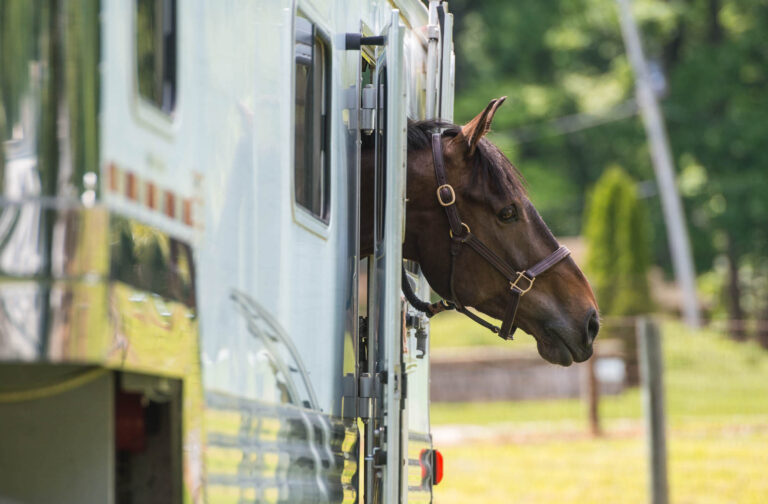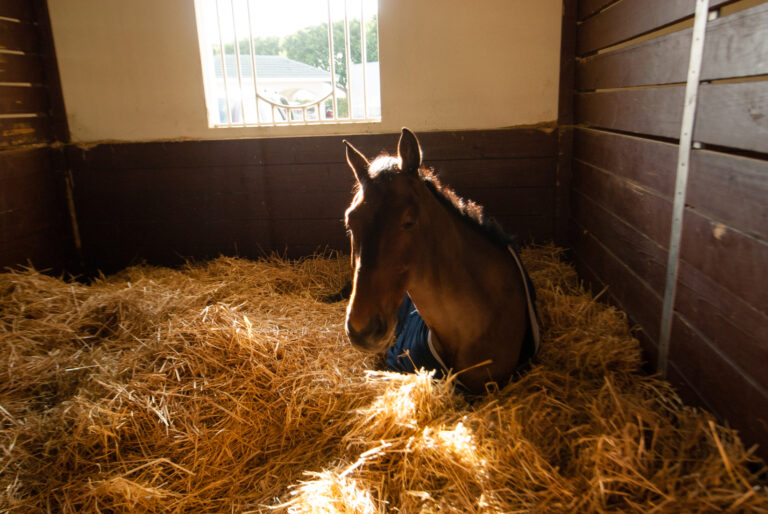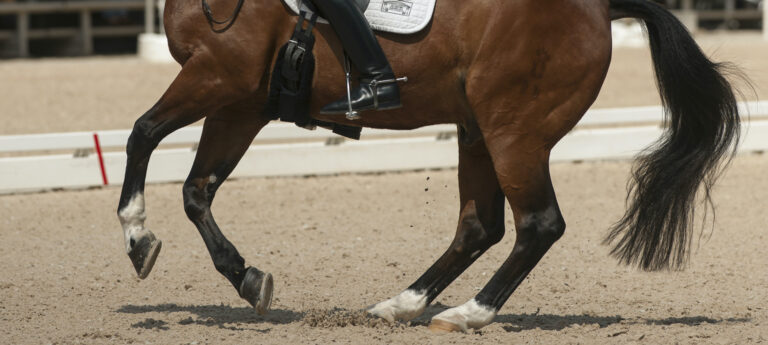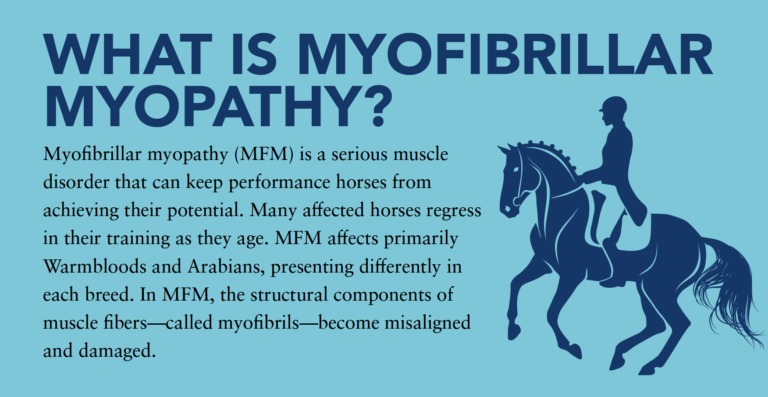If you see a horse with a long, curly hair coat, it could be a sign of Cushing’s disease in the advanced stages. But the disease can start with much less striking signs. Douglas Langer, DVM, MS, who operates Wisconsin Equine Clinic and Hospital in Oconomowoc, Wisconsin, says that dressage horses are especially predisposed to developing Cushing’s disease due to the fact that they are often easy keepers. Following are things you need to know about the disease and what you can do to catch it early.
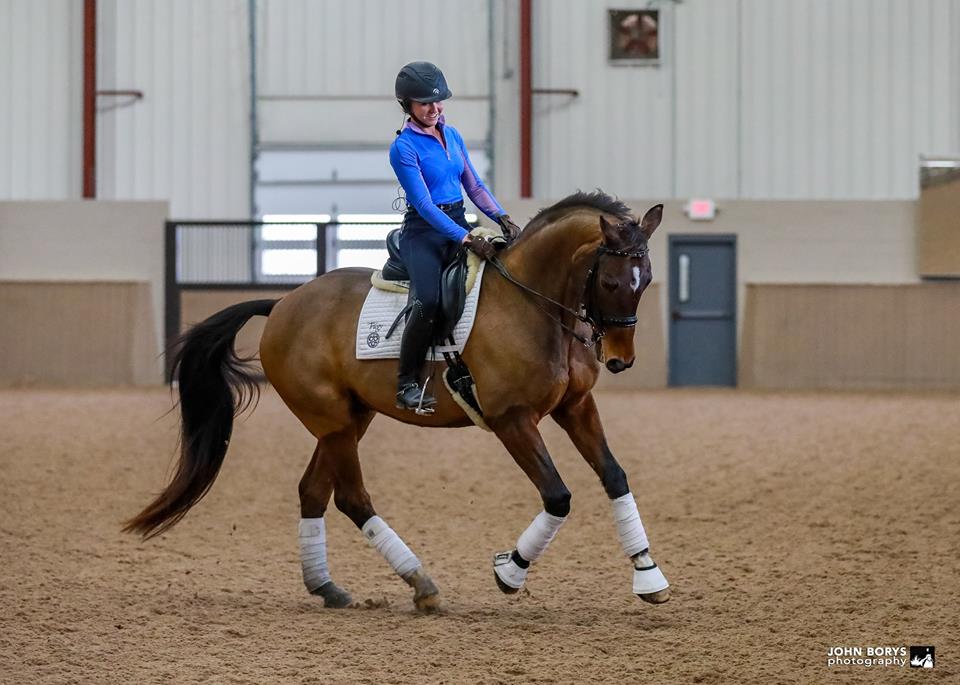
)
What is Cushing’s Disease?
Cushing’s disease is a condition where the pituitary gland, also referred to as pars intermedia, enlarges in the brain. The pituitary gland is responsible for regulating the body’s hormones. In a horse suffering from Cushing’s disease, there either is not enough dopamine present or the body is not adequately recognizing it. This has an effect on the adrenal glands and the kidneys, and the horse becomes prone to having infections. In severe cases, Cushing’s disease can cause neurologic disease.
Classic clinical signs in horses include a long, curly hair coat, a cresty neck, abnormal fat deposits and poor shedding habits. Some older horses lose muscle mass. Most afflicted horses are older, but younger horses can develop Cushing’s disease as well.
Gabrielle Jolin’s 20-year-old, Third Level Hanoverian gelding, Fievel, had all the classic signs of Cushing’s disease when he was diagnosed. “My instructor and I suspected it during the late winter/early spring of 2016 when he was 19,” she says. “His coat wasn’t shedding out very well and he was very wooly. He had also lost a lot of topline muscle, was sweating excessively and was urinating quite frequently.”
Other more subtle indicators include being overweight as well as aberrant insulin levels in the blood. Many Cushing’s horses develop laminitis. Sore feet after trimming can be a symptom. “Any horse who gets sore after his feet are trimmed and founders, but there is no explanation why it happens—80 to 90 percent of these horses have Cushing’s disease or Equine Metabolic Syndrome [EMS],” says Langer.
Complications from Cushings and EMS
Researchers have found that although Cushing’s disease and EMS are not the same thing, there is a strong link between the two. Both conditions are linked to insulin resistance, diabetes, laminitis and/or foundering if untreated. “It is a complex of the two that we are often dealing with,” Langer explains. “As horses gain weight, EMS concerns go up and their insulin levels tend to rise, which can over time trigger a laminitic episode. If the horse is also mildly Cushingoid, that very quickly can trigger a laminitic episode, especially if he has joint injections with steroids. The joint injections can tip the scales,” Langer explains. He adds that founders triggered by steroids are usually among the most severe cases. If the horse is a candidate for joint injections, Langer routinely plans on testing for both Cushing’s disease and EMS.
“If I am concerned about either condition—Cushing’s or EMS—I treat the horse with joint medications that don’t predispose him to foundering. Hyaluronic acid is a safe joint supplement to administer. Regenerative therapies such as IRAP [Interleukin 1 Receptor Antagonist Protein], Pro-Stride and platelet-rich plasma are suitable options as well.” He adds that there is a new medication for such horses that is currently being used on an experimental basis—polyacrylamide gel, an artificial joint lubricant that will be on the market soon.
Testing for Cushings and EMS
When suspecting a horse has signs of EMS, Cushing’s disease or receives steroid injections, veterinarians ideally test the horse’s ACTH and insulin levels prior to any treatment. ACTH stands for adrenocorticotropic hormone, and its levels indicate if the horse has Cushing’s disease. “What we are looking for are higher-than-normal ACTH levels,” Langer says. “With Cushing’s disease, if the ACTH level is not high and I still suspect this disease, we may do a TRH [thyrotropin-releasing hormone] stimulation test to see if there is a normal response or not.”
Katrina Hiller, of Walworth, Wisconsin, experienced how joint injections can suddenly trigger laminitis due to elevated ACTH levels in her 17-year-old Oldenburg gelding, Toy Soldier, whom she has had since he was 3 and whom she has trained to Grand Prix. “He has always struggled with his weight,” she says. “I had trouble keeping the weight off. He always had a cresty neck and fat deposits. Then, in the summer of 2016, four days after his stifles were injected with corticosteroids, he suddenly developed laminitis. [Receiving the steroid injections] was routine for him. I had his ACTH levels tested every year. He was always fine. We tested him after the injection and his ACTH levels were very high.”
Treatment
While there is no cure for Cushing’s disease, drugs can help relieve the clinical signs. Cyproheptadine was once the drug of choice for treatment. Some horses respond well to pergolide (Prascend) and sometimes it is used in conjuction with cyproheptadine. Toy Soldier’s ACTH levels had improved so dramatically on pergolide that Hiller took him off it. “We tried to take him off the medication. He was OK for about six weeks and then he had another laminitis flare-up.”
Jolin’s gelding, Fievel, is still relatively stable without medication. “We have been retesting his ACTH levels every spring and watching them. If his clinical signs worsen or if his levels get considerably higher, we will start medicating.”
Precautions to Lower the Risks
Although Cushing’s disease cannot always be prevented, there are precautions you can take to lower the risk. “The most important thing is to keep your horse’s weight down, providing proper nutrition, which means to feed him only what he really needs,” Langer says. Sugar intake should be minimized. “Feeding too many carrots, apples or treats is a contributing factor. Avoid it in horses that are predisposed. When you have an easy keeper, it is wise to put on a grazing muzzle when turning him out on pasture.
Hiller changed Toy Soldier’s diet after the diagnosis, taking out all sugar, including treats and grass. “We stopped his diet of alfalfa pellets, beet pulp and vitamin supplements. We had to find a way to give him enough protein and fat without the sugar. The sugar caused laminitis. I gave him a protein supplement safe for metabolic horses that really helped to get his muscle tone and energy back.” Jolin’s gelding, Fievel, is on a controlled low-sugar/low-starch diet and stays clipped for most of the year.
Since pergolide is on the FEI list of prohibited substances, Hiller no longer competes her horse. However, she is still schooling all the Grand Prix movements and is participating in clinics, although the medication has changed her horse’s energy levels. “His energy is pretty low. And he got really stiff. He has to have a much longer warm-up time. On days where he can’t work through the stiffness, I take him for a hack or let him be and give him more easy stretch days. About twice a week I can school the harder movements.” She adds that now that the pressure of showing is gone, she can focus more on herself in her riding.
Jolin hasn’t given up her goal of earning her USDF bronze medal with her Cushing’s horse. “It was my first time out at Third Level this past show season and I’m looking to improve and hopefully achieve this before I go to college in the fall.”
If you are concerned your horse might develop Cushing’s disease, you can help minimize its impact. Make sure your horse maintains a healthy weight and reduce his sugar intake. Feed your horse only what he really needs.
If your horse is overweight or has been diagnosed with Cushing’s disease and needs treatment for degenerative joint disease, prevent complications by choosing joint medications that are safe for Cushingoid horses and stay away from corticosteroids. Relieve your horse’s Cushing’s signs by keeping him on pergolide or cyproheptadine. When managed properly, horses with Cushing’s disease can lead long and useful lives as dressage partners.
Douglas L. Langer, DVM, MS, received his veterinary medicine degree from the University of Minnesota in 1989, a Masters degree in nutrition from the University of Kentucky in 1985, completed a large animal internship at the University of Guelph in 1990 and an equine surgery and lameness residency at the University of California-Davis in 1993. He is the current president of the Wisconsin Equine Clinic and Hospital in Oconomowoc, Wisconsin, where he has practiced for the last 24 years, and serves as director of the departments of surgery and advanced diagnostic imaging. While specializing in sport-horse lameness and surgery, he incorporates the latest diagnostic and treatment modalities to improve long-term health and soundness of the equine athlete and is actively involved in advancements in equine lameness, surgery and advanced regenerative therapies. He and his wife, Shannon, own Maple Run Farm, LLC, a Hanoverian breeding farm in southeastern Wisconsin.


